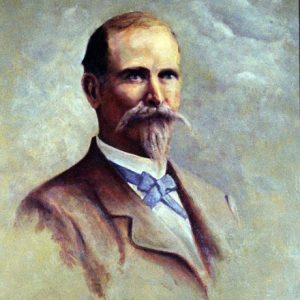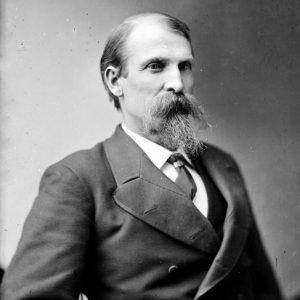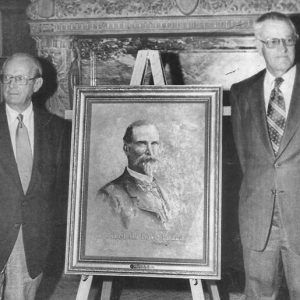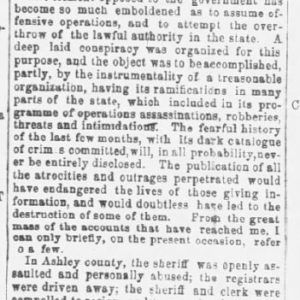calsfoundation@cals.org
Powell Clayton (1833–1914)
Ninth Governor (1868–1871)
Powell Clayton, a Union general who settled in Arkansas following the Civil War, played a prominent role as a Republican politician in the Reconstruction that followed that conflict. He became the first governor after the state’s readmission in the Union and pursued social, economic, and political policies typical of Republican regimes elsewhere in the South. He subsequently became an important figure in that party’s national politics until the time of his death.
Clayton was born in Bethel Township, Pennsylvania, on August 7, 1833, to John Clayton, a carpenter who kept an orchard, and Ann Clarke Clayton. Clayton attended local public schools and the Partridge Military Academy in Bristol, Pennsylvania. As a young adult, he studied civil engineering in Wilmington, Delaware, then moved to Leavenworth, Kansas, in 1855 to work as a surveyor. He also speculated in land in Kansas. Clayton’s family engaged in Whig politics in Pennsylvania, then shifted to the Republican Party in the 1850s. He first entered politics in 1860 when he ran successfully for city engineer in Leavenworth.
At the outbreak of the Civil War, Clayton joined the Union army in May 1861 and was elected captain of Company E, First Kansas Infantry. Clayton showed early evidence of his abilities as a leader when his unit saw action in support of Totten’s Battery in the Battle of Wilson’s Creek, Missouri, in August 1861. The unit suffered severe casualties, and his company lost forty-nine of its seventy-four men. Clayton received a citation for his leadership in the battle. In February 1862, he received a commission as lieutenant colonel of the Fifth Kansas Cavalry, after having acted in that capacity since the previous December. A month later, he was promoted to colonel of the regiment. The Fifth Kansas moved to Arkansas later in 1862 and was stationed at Helena (Phillips County). It fought guerillas outside of Helena and carried out at least one significant raid up the St. Francis River in March 1863. At the Battle of Helena on July 4, 1863, Clayton commanded the cavalry brigade on the right flank of the Union forces and received additional commendations for his performance. In August and September, the regiment accompanied General Frederick Steele’s force in his campaign against Little Rock (Pulaski County).
In October 1863, Steele named him to command the post at Pine Bluff (Jefferson County). On October 25, 1863, a Confederate force under General John S. Marmaduke attacked the city. With his forces badly outnumbered, Clayton effectively used freedmen to build barricades in the streets and put out fires started by the attackers to block the assault. He remained at this post through the rest of the war and led numerous expeditions into the surrounding countryside, including ones in the spring of 1864 in support of Steele’s Camden Expedition. He received a promotion to brigadier general on August 1, 1864. When mustered out of the service in August 1865, he commanded the cavalry division of the Seventh Army Corps.
Clayton leased a captured plantation in Pine Bluff from the Treasury Department during the war and made enough money for him and his brothers to purchase a plantation near Pine Bluff in the last year of the war. They settled there at the war’s end. He continued to operate the plantation, although usually absent from it, for the rest of his life and ultimately accumulated 40,000 acres of land. On December 14, 1865, he married Adaline McGraw of Helena. The couple had three daughters and two sons, although one of the sons died in infancy.
In 1867, with the beginning of Congressional Reconstruction, Clayton participated in the formation of the state Republican Party. He attributed his decision to enter Arkansas politics in part to confrontations with ex-rebels on his plantation that convinced him that Unionists needed greater protection. He quickly emerged as a leader of that party, serving as a delegate to the party’s state convention in April 1867. That convention already evidenced divisions within the fledgling party when Clayton, an outsider, faced James M. Johnson, for the party’s nomination. Clayton received the nomination, was elected, and was inaugurated governor on July 2, 1868.
As governor, Clayton faced strident opposition from the state’s conservative political leaders who labeled him a “Radical Republican,” along with a serious outbreak of violence, aimed at African Americans and members of the Republican Party, led by the Ku Klux Klan during the presidential election in the fall of 1868. In this period, one Republican congressman, James Hinds, was assassinated, and Clayton himself survived an attempt on his life. The governor responded to the emergence of the Klan more decisively than did the governors of most Southern states. He organized the state militia and used it throughout the state to suppress violence. His declarations of martial law in fourteen counties in 1868, despite conservative criticism to his actions, successfully ended Klan activities within the state early in his administration.
Clayton and the Republicans in the legislature accomplished much during the governor’s three-year administration. State bonds financed the construction of several railroads. Arkansas created its first free public school system. The administration and its supporters also formed the Arkansas Industrial University, the basis for the future University of Arkansas (UA) in Fayetteville (Washington County). What would become the Arkansas School for the Deaf was established, and the Arkansas School for the Blind was relocated from Arkadelphia (Clark County) to Little Rock.
As in other Southern states, the Republican Party in Arkansas quickly splintered in the face of serious opposition from conservatives, dividing along ideological and personal lines. Clayton and his faction, known locally as the “Minstrels,” came to dominate the party organization, securing recognition of the national Republican organization and commanding the federal patronage in the state. His position earned Clayton few friends within the state Republican Party, and he faced repeated challenges to his leadership. By 1868, Joseph Brooks, who had been instrumental in the formation of the Arkansas Republican Party in 1867, had broken with Clayton and led another faction given the nickname “Brindletails.” Brooks’s opposition to Clayton developed partly because of Clayton’s increasingly moderate stance toward ex-Confederates and also because of his displacement of Brooks as party leader. Additional opposition emerged in 1869 when a faction led by Lieutenant Governor James M. Johnson charged the governor with corruption in the issuing of railroad bonds and a misuse of power his attempts to suppress violence. Johnson’s backers, mostly white Republicans from northwestern Arkansas, proclaimed themselves to be supporters of reform and called themselves Liberal Republicans.
Strife among these various factions dominated Clayton’s years in office. The Brindletails managed to impeach Clayton in 1871. Clayton withstood the challenge, and the state legislature never heard the case against the governor. In January 1871, the legislature elected him to the United States Senate, setting off one of the many controversies associated with Clayton’s administration. If he took the seat, his lieutenant governor and political opponent James Johnson would have succeeded him. As a result, he refused the seat, then negotiated Johnson’s appointment as secretary of state and replacement as lieutenant governor by Ozro Hadley. In March, the legislature again elected Clayton, and he moved on to the Senate, where he remained until March 1877, when the legislature, now dominated by Democrats, elected one of their own to his seat.
After his defeat for reelection, Clayton returned to Little Rock, where he practiced law and supported general economic development. In 1882, he moved to Eureka Springs (Carroll County), where he speculated in land as the president of the Eureka Improvement Company, which encouraged the construction of a railroad to the city and the building of the Crescent Hotel. He also participated in the construction of the town’s street railway. As head of the city board, he successfully developed the sewer and water system.
Even though he did not actively pursue public office after his time in the Senate, Clayton remained the leader of the state Republican Party until his death, even as the party was increasingly sidelined through election fraud and violence, including the murder of his brother, John Middleton Clayton. He was part of the state’s delegation to every Republican National Convention from 1872 to 1896. In 1896, he took an active role in William McKinley’s presidential campaign. After he was elected, McKinley rewarded Clayton by appointing him the United States’ minister to Mexico in 1897. McKinley named him the first ambassador to Mexico in 1899 when that post was raised to an embassy post, and Clayton continued to hold this office under McKinley’s successor, Theodore Roosevelt. He resigned for personal reasons in 1905. When he retired from the Mexican embassy, Clayton became a resident of Washington DC, although he maintained various business enterprises in Arkansas and continued to be a major power within the local Republican Party.
Clayton died in Washington DC on August 25, 1914, and is buried in Arlington National Cemetery. The year after his death, his book The Aftermath of the Civil War in Arkansas was published.
For additional information:
Barnes, Kenneth C. Who Killed John Clayton? Political Violence and the Emergence of the New South, 1861–1893. Durham, NC: Duke University Press, 1998.
Burnside, William H. The Honorable Powell Clayton. Conway: University of Central Arkansas Press, 1991.
Christ, Mark K. Civil War Arkansas, 1863: The Battle for a State. Norman: University of Oklahoma Press, 2010.
Clayton, Powell. The Aftermath of the Civil War in Arkansas. New York: The Neale Publishing Company, 1915. Online at https://www.loc.gov/item/15004463/ (accessed March 6, 2024).
DeBlack, Thomas A. With Fire and Sword: Arkansas, 1861–1874. Fayetteville: University of Arkansas Press, 1998.
Donovan, Timothy P., Willard B. Gatewood Jr., and Jeannie M. Whayne, eds. Governors of Arkansas: Essays in Political Biography. 2d ed. Fayetteville: University of Arkansas Press, 1981.
Moneyhon, Carl. The Impact of the Civil War and Reconstruction on Arkansas: Persistence in the Midst of Ruin. Baton Rouge: Louisiana State University Press, 1994.
Carl H. Moneyhon
University of Arkansas at Little Rock
 Civil War through Reconstruction, 1861 through 1874
Civil War through Reconstruction, 1861 through 1874 Military
Military Politics and Government
Politics and Government Powell Clayton
Powell Clayton  Powell Clayton
Powell Clayton  Powell Clayton Portrait
Powell Clayton Portrait  Governor's Message
Governor's Message 



Comments
No comments on this entry yet.